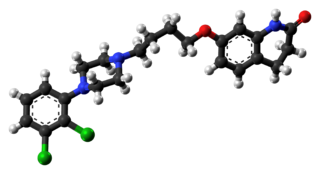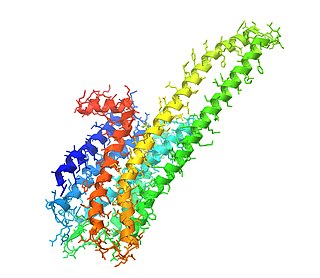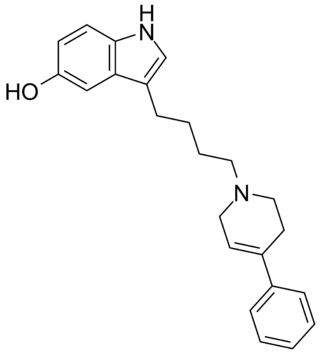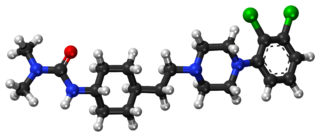Related Research Articles

Aripiprazole, sold under the brand names Abilify and Aristada, among others, is an atypical antipsychotic. It is primarily used in the treatment of schizophrenia and bipolar disorder; other uses include as an add-on treatment in major depressive disorder and obsessive–compulsive disorder (OCD), tic disorders, and irritability associated with autism. Aripiprazole is taken by mouth or via injection into a muscle. A Cochrane review found low-quality evidence of effectiveness in treating schizophrenia.

Mirtazapine, sold under the brand name Remeron among others, is an atypical tetracyclic antidepressant, and as such is used primarily to treat depression. Its effects may take up to four weeks but can also manifest as early as one to two weeks. It is often used in cases of depression complicated by anxiety or insomnia. The effectiveness of mirtazapine is comparable to other commonly prescribed antidepressants. It is taken by mouth.

Trazodone, sold under many brand names, is an antidepressant medication, used to treat major depressive disorder, anxiety disorders, and insomnia. It is a phenylpiperazine compound of the serotonin antagonist and reuptake inhibitor (SARI) class. The medication is taken orally.

The 5-HT2A receptor is a subtype of the 5-HT2 receptor that belongs to the serotonin receptor family and is a G protein-coupled receptor (GPCR). The 5-HT2A receptor is a cell surface receptor, but has several intracellular locations.

A serotonin receptor agonist is an agonist of one or more serotonin receptors. They activate serotonin receptors in a manner similar to that of serotonin, a neurotransmitter and hormone and the endogenous ligand of the serotonin receptors.

Pipamperone, sold under the brand name Dipiperon, is a typical antipsychotic of the butyrophenone family used in the treatment of schizophrenia and as a sleep aid for depression. It is or has been marketed under brand names including Dipiperon, Dipiperal, Piperonil, Piperonyl, and Propitan. Pipamperone was discovered at Janssen Pharmaceutica in 1961, and entered clinical trials in the United States in 1963.

Eplivanserin was an experimental drug for the treatment of insomnia which was being developed by Sanofi Aventis.

Pimavanserin, sold under the brand name Nuplazid, is an atypical antipsychotic which is approved for the treatment of Parkinson's disease psychosis. Unlike other antipsychotics, pimavanserin is not a dopamine receptor antagonist, but rather is a selective inverse agonist of the serotonin 5-HT2A receptor.

Volinanserin (INN) is a highly selective 5-HT2A receptor antagonist that is frequently used in scientific research to investigate the function of the 5-HT2A receptor. It was also tested in clinical trials as a potential antipsychotic, antidepressant, and treatment for insomnia but was never marketed.

Adatanserin is a mixed 5-HT1A receptor partial agonist and 5-HT2A and 5-HT2C receptor antagonist. It was under development by Wyeth as an antidepressant but was ultimately not pursued.

Roxindole (EMD-49,980) is a dopaminergic and serotonergic drug which was originally developed by Merck KGaA for the treatment of schizophrenia. In clinical trials its antipsychotic efficacy was only modest but it was unexpectedly found to produce potent and rapid antidepressant and anxiolytic effects. As a result, roxindole was further researched for the treatment of depression instead. It has also been investigated as a therapy for Parkinson's disease and prolactinoma.

Pruvanserin is a selective 5-HT2A receptor antagonist which was under development by Eli Lilly and Company for the treatment of insomnia. It was in phase II clinical trials in 2008 but appears to have been discontinued as it is no longer in the company's development pipeline. In addition to its sleep-improving properties, pruvanserin has also been shown to have antidepressant, anxiolytic, and working memory-enhancing effects in animal studies.

Cariprazine, sold under the brand name Vraylar among others, is an atypical antipsychotic developed by Gedeon Richter, which is used in the treatment of schizophrenia, bipolar mania, bipolar depression, and major depressive disorder. It acts primarily as a D3 and D2 receptor partial agonist, with a preference for the D3 receptor. Cariprazine is also a partial agonist at the serotonin 5-HT1A receptor and acts as an antagonist at 5-HT2B and 5-HT2A receptors, with high selectivity for the D3 receptor. It is taken by mouth.

Substituted tryptamines, or serotonin analogues, are organic compounds which may be thought of as being derived from tryptamine itself. The molecular structures of all tryptamines contain an indole ring, joined to an amino (NH2) group via an ethyl (−CH2–CH2−) sidechain. In substituted tryptamines, the indole ring, sidechain, and/or amino group are modified by substituting another group for one of the hydrogen (H) atoms.

Brexpiprazole, sold under the brand name Rexulti among others, is an atypical antipsychotic medication used for the treatment of major depressive disorder, schizophrenia, and agitation associated with dementia due to Alzheimer's disease.

Neurolixis is a biopharmaceutical company focused on novel drugs for the treatment of human central nervous system diseases.

5-Fluoro-MET (5F-MET, 5-fluoro-N-methyl-N-ethyltryptamine) is a psychedelic tryptamine derivative related to drugs such as 5-Fluoro-DMT and N-Methyl-N-ethyltryptamine (MET). It acts as an agonist at the 5-HT2A receptor with an EC50 of 20.6 nM and produces a head-twitch response in animal studies. Ring fluorination in this case increases efficacy at 5-HT2A, with 5F-MET having an efficacy of 87.6% vs 5-HT, vs 36.2% for the partial agonist MET. It is claimed to have antidepressant activity.

LPH-5 is a psychedelic discovered by Emil Marcher-Rørsted, Jesper L. Kristensen and Anders A. Jensen at Danish biopharmaceutical company Lophora. It is a conformationally-restricted derivative of the phenethylamine 2C-TFM, also a hallucinogen, and acts as a potent agonist of the 5-HT2A receptor (EC50 = 3.2 nM, Emax = 78%). It shows 10- to 100-fold selectivity for the 5-HT2A receptor over the 5-HT2B and 5-HT2C receptors and, along with related compounds like 25CN-NBOH, is said to be one of the few truly selective 5-HT2A receptor agonists. LPH-5 is expected to avoid the cardiac risks of 5-HT2B receptor activation.
References
- 1 2 3 "GM 2505". AdisInsight. 22 March 2024. Retrieved 30 August 2024.
- ↑ Witkin JM, Golani LK, Smith JL (April 2023). "Clinical pharmacological innovation in the treatment of depression". Expert Rev Clin Pharmacol. 16 (4): 349–362. doi:10.1080/17512433.2023.2198703. PMID 37000975.
GM-2505 is a dual-acting compound with both agonist activity at 5-HT 2A receptors and a releaser of 5-HT. [...]
- 1 2 Conference-poster: Hughes, Zoe; Klein, Adam; Dvorak, Dino; Austin, Eric; Kiss, Laszlo; Marek, Gerard; Sporn, Jonathan; Kruegel, Andrew (2023). "22. GM-2505 has Rapid Onset Antidepressant Activity and Causes Dose-Dependent Changes in qEEG With Increasing 5-HT2A Receptor Occupancy". Biological Psychiatry. 93 (9): S102–S103. doi:10.1016/j.biopsych.2023.02.262.
- ↑ Beaney, Abigail (6 December 2023). "Gilgamesh to initiate Phase IIa trial of fast-acting psychedelic drug". Clinical Trials Arena. Retrieved 7 December 2023.